tow MAZDA MODEL RX 8 2006 (in English) Owner's Manual
[x] Cancel search | Manufacturer: MAZDA, Model Year: 2006, Model line: MODEL RX 8, Model: MAZDA MODEL RX 8 2006Pages: 434
Page 271 of 434
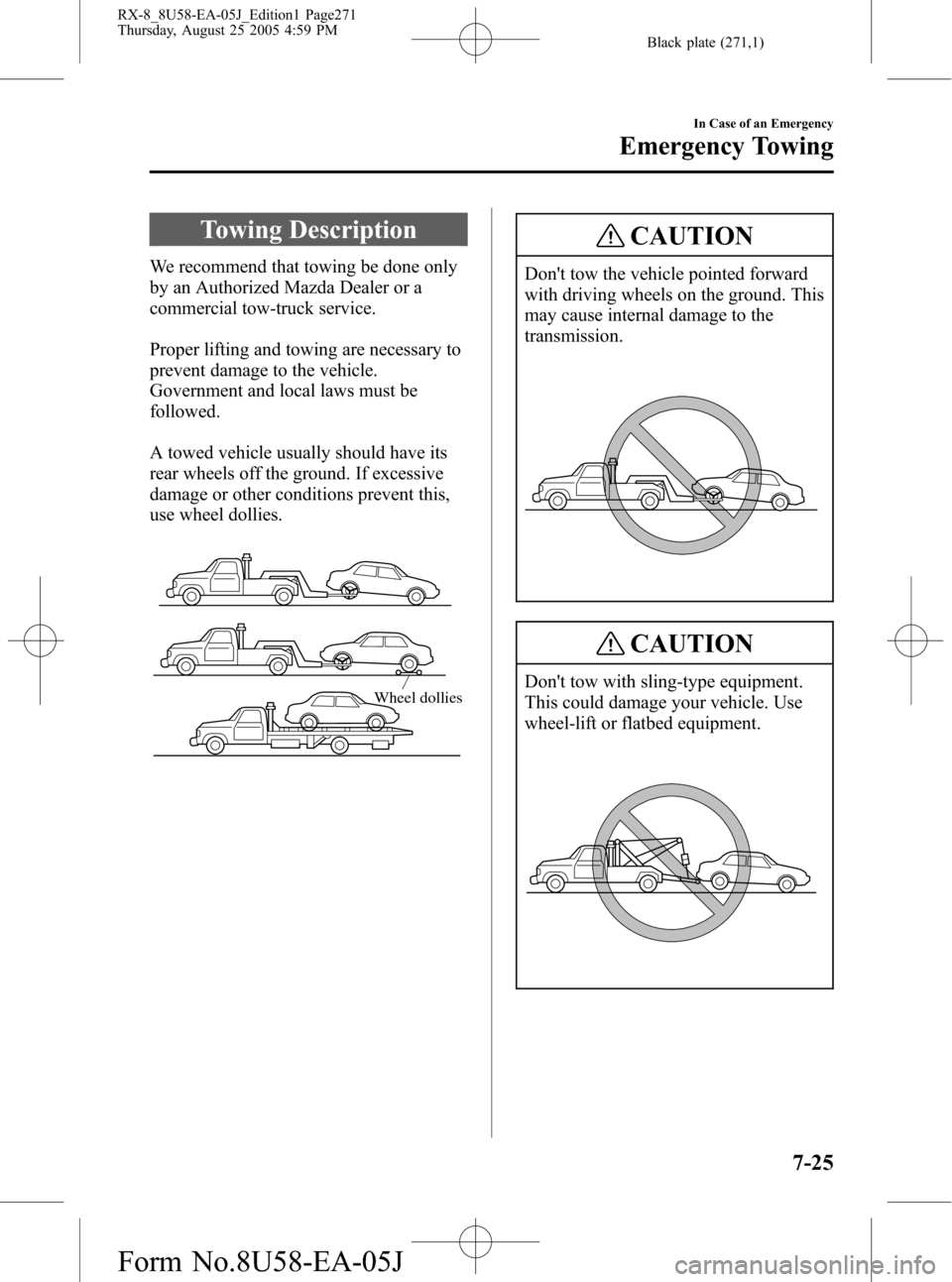
Black plate (271,1)
Towing Description
We recommend that towing be done only
by an Authorized Mazda Dealer or a
commercial tow-truck service.
Proper lifting and towing are necessary to
prevent damage to the vehicle.
Government and local laws must be
followed.
A towed vehicle usually should have its
rear wheels off the ground. If excessive
damage or other conditions prevent this,
use wheel dollies.
Wheel dollies
CAUTION
Don't tow the vehicle pointed forward
with driving wheels on the ground. This
may cause internal damage to the
transmission.
CAUTION
Don't tow with sling-type equipment.
This could damage your vehicle. Use
wheel-lift or flatbed equipment.
In Case of an Emergency
Emergency Towing
7-25
RX-8_8U58-EA-05J_Edition1 Page271
Thursday, August 25 2005 4:59 PM
Form No.8U58-EA-05J
Page 272 of 434
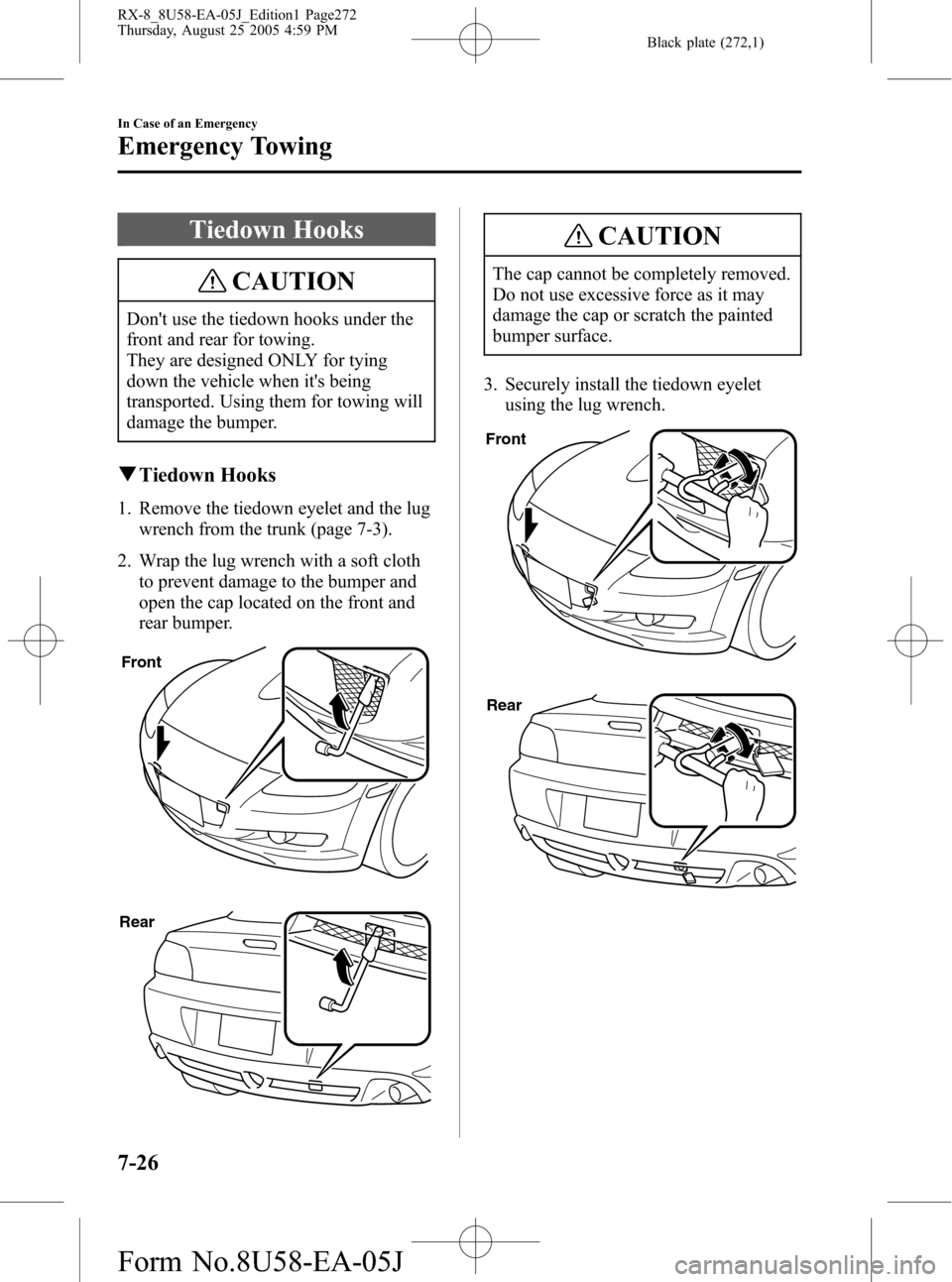
Black plate (272,1)
Tiedown Hooks
CAUTION
Don't use the tiedown hooks under the
front and rear for towing.
They are designed ONLY for tying
down the vehicle when it's being
transported. Using them for towing will
damage the bumper.
qTiedown Hooks
1. Remove the tiedown eyelet and the lug
wrench from the trunk (page 7-3).
2. Wrap the lug wrench with a soft cloth
to prevent damage to the bumper and
open the cap located on the front and
rear bumper.
Front
Rear
CAUTION
The cap cannot be completely removed.
Do not use excessive force as it may
damage the cap or scratch the painted
bumper surface.
3. Securely install the tiedown eyelet
using the lug wrench.
Front
Rear
7-26
In Case of an Emergency
Emergency Towing
RX-8_8U58-EA-05J_Edition1 Page272
Thursday, August 25 2005 4:59 PM
Form No.8U58-EA-05J
Page 273 of 434
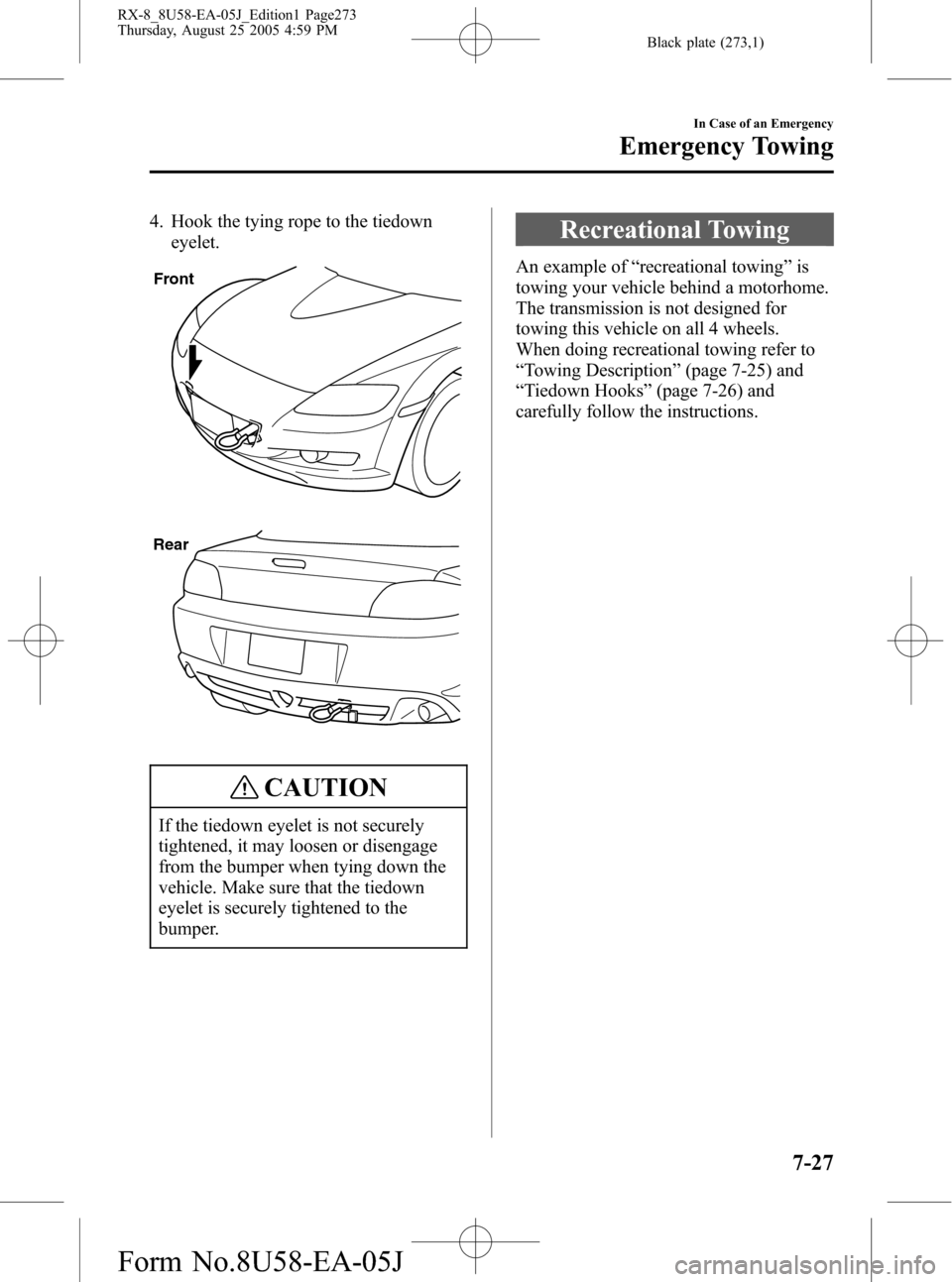
Black plate (273,1)
4. Hook the tying rope to the tiedown
eyelet.
Front
Rear
CAUTION
If the tiedown eyelet is not securely
tightened, it may loosen or disengage
from the bumper when tying down the
vehicle. Make sure that the tiedown
eyelet is securely tightened to the
bumper.
Recreational Towing
An example of“recreational towing”is
towing your vehicle behind a motorhome.
The transmission is not designed for
towing this vehicle on all 4 wheels.
When doing recreational towing refer to
“Towing Description”(page 7-25) and
“Tiedown Hooks”(page 7-26) and
carefully follow the instructions.
In Case of an Emergency
Emergency Towing
7-27
RX-8_8U58-EA-05J_Edition1 Page273
Thursday, August 25 2005 4:59 PM
Form No.8U58-EA-05J
Page 297 of 434

Black plate (297,1)
2. Hold the end of the rubber and pull
until the tabs are free of the metal
support.
Metal support
Ta b
3. Remove the metal stiffeners from the
blade rubber and install them in new
blades.
CAUTION
lDon't bend or discard the stiffeners.
You need to use them again.
lIf the metal stiffeners are switched,
the blade's wiping efficiency could
be reduced.
So don't use the driver's side metal
stiffeners on the passenger's side, or
vice versa.
lBe sure to reinstall the metal
stiffeners in the new blade rubber so
that the curve is the same as it was in
the old blade rubber.
4. Carefully insert the new blade rubber.
Then install the blade assembly in the
reverse order of removal.
NOTE
Install the blade so that the tabs are
toward the bottom of the wiper arm.
Maintenance and Care
Owner Maintenance
8-23
RX-8_8U58-EA-05J_Edition1 Page297
Thursday, August 25 2005 4:59 PM
Form No.8U58-EA-05J
Page 353 of 434

Black plate (353,1)
NOTE
Tires degrade over time, even when they are not being used on the road. It is
recommended that tires generally be replaced when they are 6 years or older. Heat
caused by hot climates or frequent high loading conditions can accelerate the aging
process. You should replace the spare tire when you replace the other road tires due to
the aging of the spare tire. Regarding the manufacturing week and year is indicated with
4 digit. Refer to The tire labeling on page 9-18.
qSafety Practices
The way you drive has a great deal to do with your tire mileage and safety. So cultivate
good driving habits for your own benefit.
lObserve posted speed limits
lAvoid fast starts, stops and turns
lAvoid potholes and objects on the road
lDo no run over curbs or hit the tire against the curb when parking
CAUTION
If you feel a sudden vibration or ride disturbance while driving or you suspect your tire
or vehicle has been damaged, immediately reduce your speed. Drive with caution until
you can safely pull off the road. Stop and inspect the tire for damage. If the tire is under-
inflated or damaged, deflate it, remove the tire and rim and replace it with your spare
tire. If you cannot detect a cause, have the vehicle towed to the nearest vehicle or tire
dealer to have the vehicle inspected.
Customer Information and Reporting Safety Defects
Tire Information (U.S.A.)
9-29
RX-8_8U58-EA-05J_Edition1 Page353
Thursday, August 25 2005 5:0 PM
Form No.8U58-EA-05J
Page 354 of 434
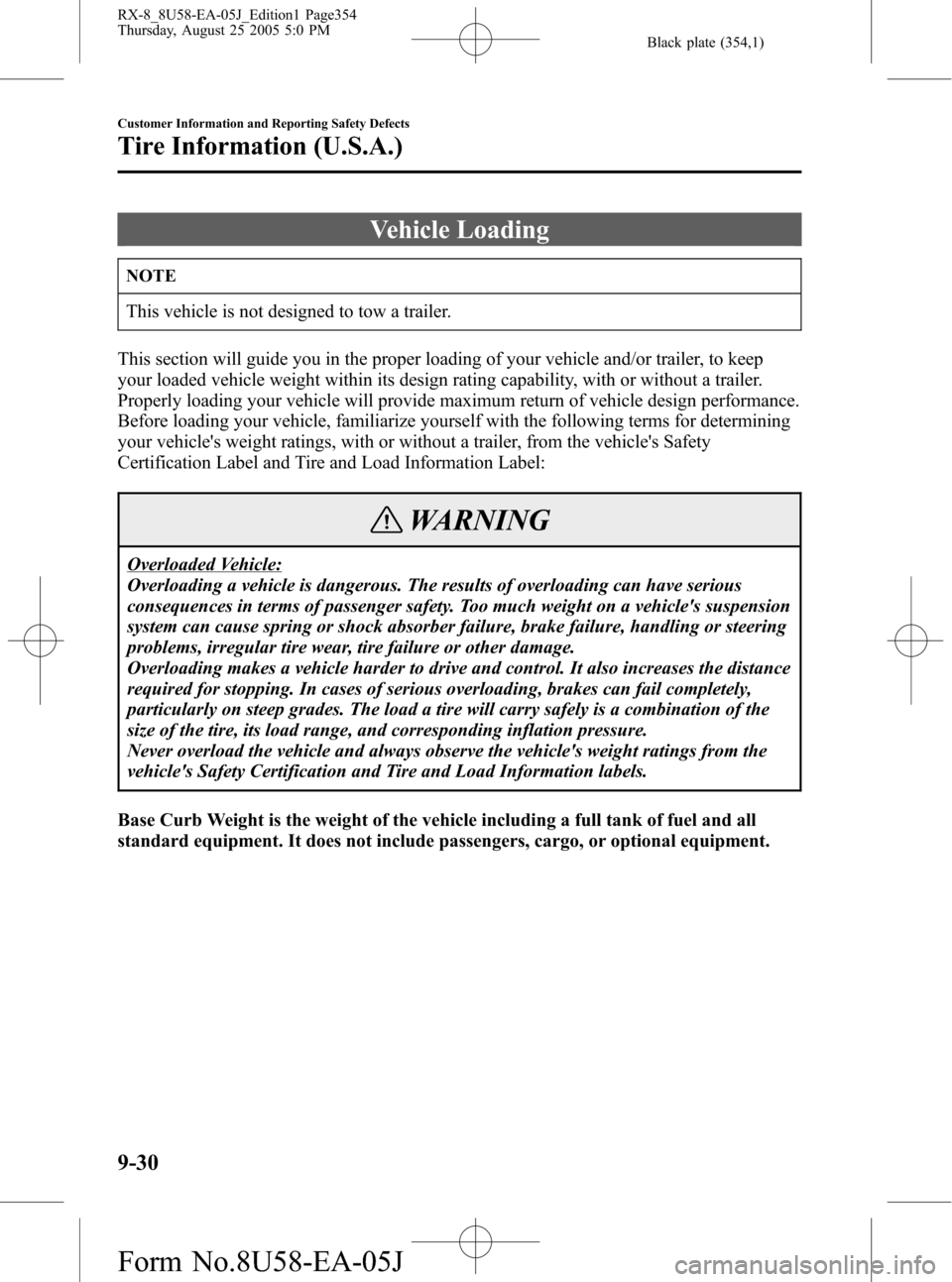
Black plate (354,1)
Vehicle Loading
NOTE
This vehicle is not designed to tow a trailer.
This section will guide you in the proper loading of your vehicle and/or trailer, to keep
your loaded vehicle weight within its design rating capability, with or without a trailer.
Properly loading your vehicle will provide maximum return of vehicle design performance.
Before loading your vehicle, familiarize yourself with the following terms for determining
your vehicle's weight ratings, with or without a trailer, from the vehicle's Safety
Certification Label and Tire and Load Information Label:
WARNING
Overloaded Vehicle:
Overloading a vehicle is dangerous. The results of overloading can have serious
consequences in terms of passenger safety. Too much weight on a vehicle's suspension
system can cause spring or shock absorber failure, brake failure, handling or steering
problems, irregular tire wear, tire failure or other damage.
Overloading makes a vehicle harder to drive and control. It also increases the distance
required for stopping. In cases of serious overloading, brakes can fail completely,
particularly on steep grades. The load a tire will carry safely is a combination of the
size of the tire, its load range, and corresponding inflation pressure.
Never overload the vehicle and always observe the vehicle's weight ratings from the
vehicle's Safety Certification and Tire and Load Information labels.
Base Curb Weight is the weight of the vehicle including a full tank of fuel and all
standard equipment. It does not include passengers, cargo, or optional equipment.
9-30
Customer Information and Reporting Safety Defects
Tire Information (U.S.A.)
RX-8_8U58-EA-05J_Edition1 Page354
Thursday, August 25 2005 5:0 PM
Form No.8U58-EA-05J
Page 356 of 434
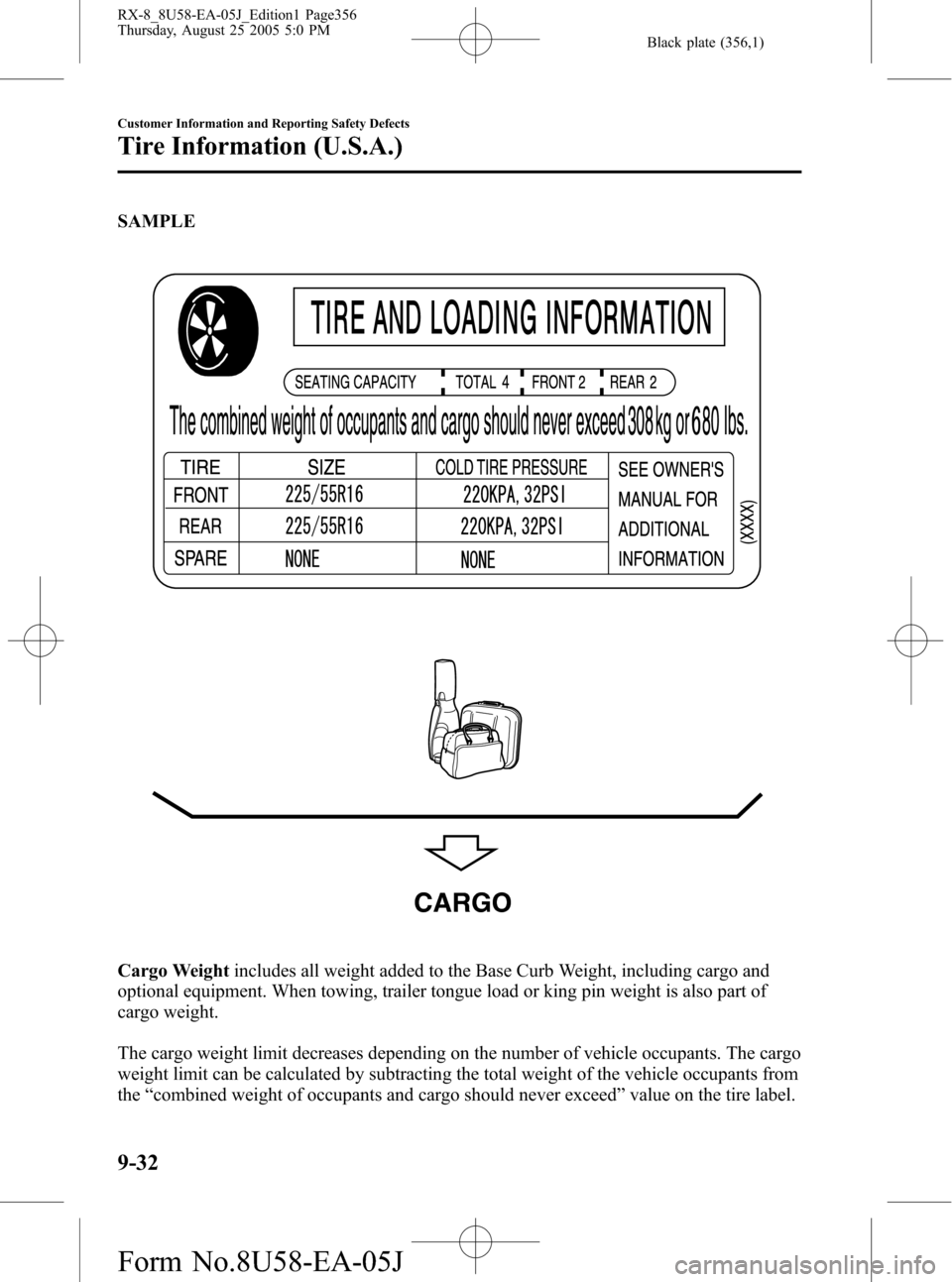
Black plate (356,1)
SAMPLE
CARGO
Cargo Weightincludes all weight added to the Base Curb Weight, including cargo and
optional equipment. When towing, trailer tongue load or king pin weight is also part of
cargo weight.
The cargo weight limit decreases depending on the number of vehicle occupants. The cargo
weight limit can be calculated by subtracting the total weight of the vehicle occupants from
the“combined weight of occupants and cargo should never exceed”value on the tire label.
9-32
Customer Information and Reporting Safety Defects
Tire Information (U.S.A.)
RX-8_8U58-EA-05J_Edition1 Page356
Thursday, August 25 2005 5:0 PM
Form No.8U58-EA-05J
Page 359 of 434
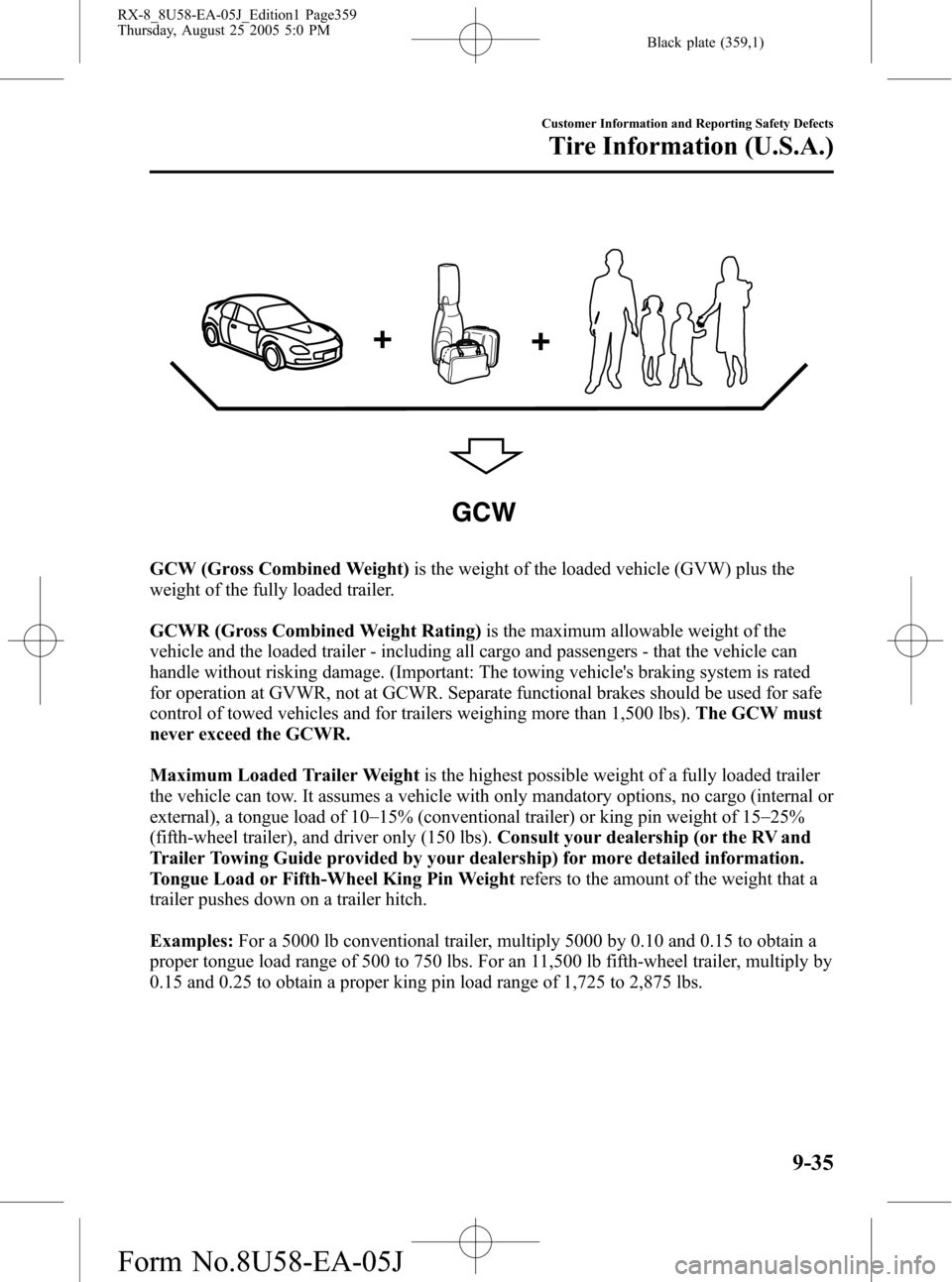
Black plate (359,1)
GCW
GCW (Gross Combined Weight)is the weight of the loaded vehicle (GVW) plus the
weight of the fully loaded trailer.
GCWR (Gross Combined Weight Rating)is the maximum allowable weight of the
vehicle and the loaded trailer - including all cargo and passengers - that the vehicle can
handle without risking damage. (Important: The towing vehicle's braking system is rated
for operation at GVWR, not at GCWR. Separate functional brakes should be used for safe
control of towed vehicles and for trailers weighing more than 1,500 lbs).The GCW must
never exceed the GCWR.
Maximum Loaded Trailer Weightis the highest possible weight of a fully loaded trailer
the vehicle can tow. It assumes a vehicle with only mandatory options, no cargo (internal or
external), a tongue load of 10_
15% (conventional trailer) or king pin weight of 15_
25%
(fifth-wheel trailer), and driver only (150 lbs).Consult your dealership (or the RV and
Trailer Towing Guide provided by your dealership) for more detailed information.
Tongue Load or Fifth-Wheel King Pin Weightrefers to the amount of the weight that a
trailer pushes down on a trailer hitch.
Examples:For a 5000 lb conventional trailer, multiply 5000 by 0.10 and 0.15 to obtain a
proper tongue load range of 500 to 750 lbs. For an 11,500 lb fifth-wheel trailer, multiply by
0.15 and 0.25 to obtain a proper king pin load range of 1,725 to 2,875 lbs.
Customer Information and Reporting Safety Defects
Tire Information (U.S.A.)
9-35
RX-8_8U58-EA-05J_Edition1 Page359
Thursday, August 25 2005 5:0 PM
Form No.8U58-EA-05J
Page 361 of 434
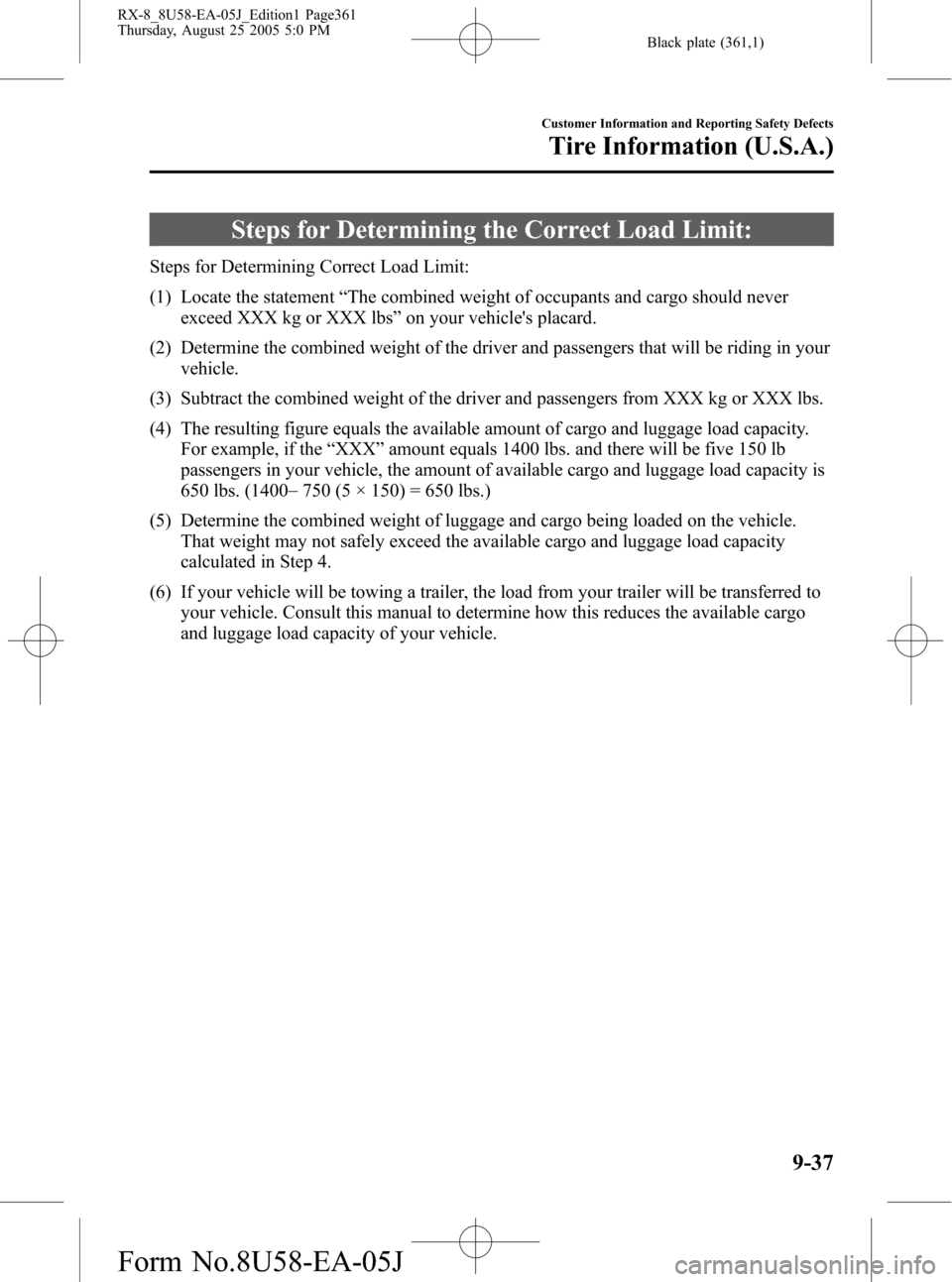
Black plate (361,1)
Steps for Determining the Correct Load Limit:
Steps for Determining Correct Load Limit:
(1) Locate the statement“The combined weight of occupants and cargo should never
exceed XXX kg or XXX lbs”on your vehicle's placard.
(2) Determine the combined weight of the driver and passengers that will be riding in your
vehicle.
(3) Subtract the combined weight of the driver and passengers from XXX kg or XXX lbs.
(4) The resulting figure equals the available amount of cargo and luggage load capacity.
For example, if the“XXX”amount equals 1400 lbs. and there will be five 150 lb
passengers in your vehicle, the amount of available cargo and luggage load capacity is
650 lbs. (1400_
750 (5 × 150) = 650 lbs.)
(5) Determine the combined weight of luggage and cargo being loaded on the vehicle.
That weight may not safely exceed the available cargo and luggage load capacity
calculated in Step 4.
(6) If your vehicle will be towing a trailer, the load from your trailer will be transferred to
your vehicle. Consult this manual to determine how this reduces the available cargo
and luggage load capacity of your vehicle.
Customer Information and Reporting Safety Defects
Tire Information (U.S.A.)
9-37
RX-8_8U58-EA-05J_Edition1 Page361
Thursday, August 25 2005 5:0 PM
Form No.8U58-EA-05J
Page 363 of 434

Black plate (363,1)
Reporting Safety Defects (Canada)
Canadian customers who wish to report a safety-related defect to Transport Canada, Defect
Investigations and Recalls, may telephone the toll free hotline 1-800-333-0510, or contact
Transport Canada by mail at: Transport Canada, ASFAD, Place de Ville Tower C, 330
Sparks Street, Ottawa ON K1A 0N5.
For additional road safety information, please visit the Road Safety website at:
http://www.tc.gc.ca/roadsafety/menu.htm
Customer Information and Reporting Safety Defects
Reporting Safety Defects
9-39
RX-8_8U58-EA-05J_Edition1 Page363
Thursday, August 25 2005 5:0 PM
Form No.8U58-EA-05J